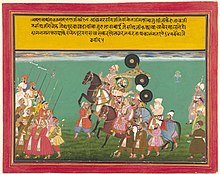|
Rajput Rebellion (1708–1710)
The Rajput rebellion began in 1708, due to the harsh treatment of the Rajput Rajas by the Mughal emperor. It erupted into a two-year rebellion that forced the Mughal emperor to sue for peace, give them gifts, and restore the Rajput holdings which had been annexed by the previous Mughal emperor Aurangzeb. Background
After the death of Aurangzeb, a battle for succession began amongst the Mughal princes. Jai Singh II and commanded a thousand troops under Bidar Bakht. On 8 June 1707, Bidar Bakht and his father Azam Shah were killed in battle and Jai Singh retreated. Bahadur Shah, as emperor, marched towards Rajputana where the Rathors under Durgadas shortly after the Rathore Rebellion. Ajit Singh had taken Jodhpur after the death of Aurangzeb and ousted Mehrab Khan and the Mughal garrisons.[3][1] During this campaign Bahadur Shah was suspicious of Jai Singh II as he had been a good friend of Bidar Bakht and fought Bahadur at Jajau. Jai Singh's younger brother Bijay Singh on the other side had been with Bahadur Shah for a longer period of time. Therefore, when Bahadur Shah stopped at Amber on 10 January 1708 on his way to Marwar, he made Bijay Singh the Raja of Amber and removed Jai Singh from his post and made him an ordinary Jagirdar. When Bahadur Shah reached close to Marwar, Ajit Singh started negotiations after seeing the size of the imperial army. On 24 March, Bahadur Shah was forced to march south due to his brother Kam Baksh's rebellion. The emperor forced Ajit Singh and Jai Singh II to march with him and empowered Bijay Singh by giving him the title of Mirza Raja. However Bijay Singh was powerless in Amber as Jai Singh's men had neutralized the Mughal authorities there. Bahadur Shah had thus repeated the Marwar scenario of Aurangzeb which had previously resulted to the thirty-year war with the Rathors. Ajit Singh and Jai Singh II fled from the Mughal camp when they got a chance at Mandleshwar on 21 April 1708, they met Maharana Amar Singh and made an alliance. Jai Singh II also married the Maharana's daughter.[3] The Rajput rebellion had thus begun.[1] RebellionThe Rajput states of Marwar and Amber united under Jai Singh II and Durgadas Rathore.[1] The Mughal regent Asad Khan attempted to make peace with the Rajputs, however this was unsuccessful. Ajit Singh and Jai Singh had taken their capitals back from the Mughal Garrisons. Jodhpur was captured in July and Amber in October 1708.[3] Mughal forces under Sayyid Hussain Barha and Churaman attempted to retake Amber, however they were defeated.[4] Jai Singh in his letter to Chattrasal has written that "among the dead were all three Faujdars".[1] The Rajputs captured the treasury in Sambhar and distributed it among the people.[5] Bahadur Shah attempted for peace with Ajit Singh and Jai Singh. The Rajputs demanded the restoration of their lands taken by Aurangzeb in 1679 and the expulsion of the Mughal forces from Rajputana. However Bahadur Shah refused and the war continued. Mughal faujdars were sent to pillage the farms and villages. Mir Khan, the faujdar of Narnol had gathered 7,000 mughals and was joined by 6,000 Jats under Churaman. However, in January 1710 this army was defeated by Gaj Singh Naruka of Javli, who was loyal to Jai Singh. On 24 March 1710, Muhammad Shah, the governor of Tonk was defeated and abandoned his holdings.[1] The Rajput Rajas had formed military outposts at Rewari and Narnaul, 45 miles from Delhi and sent their armies towards Delhi, Rohtaka and Agra. Jai Singh sent letters to the Bundelas, Sikhs and the Marathas seeking an alliance against the Mughal forces.[5] AftermathIn May 1710, Bahadur Shah negotiated with the Rajputs by sending them Gifts and letters. The rise of Banda Singh Bahadur and death of Wazir Khan, faujdar of Sirhind, further weakened the Mughal Empire. On 11 June 1710 Jai Singh and Ajit Singh were invited to the Mughal court and were given robes of honour, presents and governorships of Malwa and Gujarat.[1] See alsoReferences
Further reading
|
||||||||||||||||||||||||
